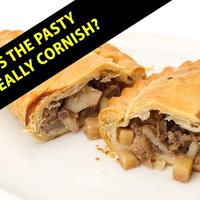Is the pasty really Cornish? 6 Minute English - YouTube
Hello. This is 6 Minute English from BBC Learning
English. I'm Neil.
And I'm Rob.
Fancy a game of ‘food connections', Rob?
So I'll name a place and you say the first
food that comes to mind. Ready?
Yeah, sure, let's go!
Italy.
Erm…'pizza' – or ‘lasagne'.
New York?
‘Hot dogs', of course. Or maybe ‘bagels'.
Now how about… Cornwall from the UK?
If it's Cornwall, it must be the famous
‘Cornish pasty', right?
That's right! Cornwall, the region which
forms the south-western tip of Britain, is
as famous for its pasties as New York is for
hot dogs. In this programme we'll be finding
out all about Cornish pasties. We'll hear
how it's gone from humble beginnings to
become a symbol of Cornish identity and spread
around the world to Jamaica, Argentina
and Brazil.
But what exactly is a pasty, Neil?
Somewhere between a pie and a sandwich,
right? A piece of pastry which is turned
over and crimped
along the side to make two corners…
… and filled with different ingredients
- which brings me to my quiz question for
today, Rob. What is the traditional filling
in an authentic Cornish pasty? Is it:
a) Chicken, avocado and brie
b) Beef, potato and turnip, or
c) Pork, onion and chorizo
Well, chorizo is Spanish isn't it? And avocado
with brie doesn't sound traditionally Cornish,
so I'll say b) beef, potato and turnip.
OK, Rob. We'll find out later if you were
right. What's for sure is that the Cornish
pasty has had a long history as BBC Radio
4's The Food Programme discovered.
They spoke to Dr Polly Russell, a public
life curator at the British Library. Here she
is reading from one of the earliest
mentions of pasties
from the late 17th century:
There's a lovely bit here where he's describing
what a housewife in Hertfordshire does and
he's talking about her way to make pork
pies and pork pasties: pies may be made and
baked either raised in paste earthen pans
or in pewter dishes or in the shape of a turnover,
two-cornered pasties. So that's a very early
reference to a pasty in the shape, I think,
that we know it but also being made specifically
for labourers - to be feeding labourers on
a farm at harvest time.
So the earliest pasties were made in pewter dishes
– a traditional cooking plate made of a
silver-coloured metal called ‘pewter'.
And they were eaten by agricultural labourers
– workers doing physical farm work during
harvest time – the weeks in autumn when
crops like wheat are cut and collected
from the fields.
But it wasn't only farmers and labourers
who ate pasties. As well as its farms and
fishing, Cornwall was famous for tin mines,
as Ruth Huxley of the Cornish Pasty
Association explains:
Pasties would have been eaten by lots of people
who went to work but it just worked perfectly
down mines, and Cornwall became the world
capital of mining. And so lots of pasties
were made, lots of pasties were eaten and
then that mining community went all over the
world and took the pasty with them.
Pasties were eaten by hungry workers involved
in the mining industry - digging up materials
such as coal or metals like gold, or in Cornwall
tin, from the ground.
So far we've been talking about Cornwall.
But you said the Cornish pasty has spread
around the world, Neil. How did that happen?
Well, that's connected to the tin miners
we just talked about. Here's
Polly Russell again:
This is replicated, not just in Mexico but
with migrants moving to America, to Minnesota,
to Canada, to Australia. So anyone who travels
to many of those places now will see foods
which are incredibly reminiscent and familiar
and just like Cornish pasties.
In the 19th century, many Cornish tin miners
emigrated, moving abroad to start a better
life. Their pasty recipes were replicated
– or copied exactly, in the new places where
they landed, from America to Australia.
And that's why in many places around the
world you can find food which is reminiscent
of pasties – meaning it reminds you of something
similar, in this case the original Cornish
pasty… with its traditional filling of…
what's was your quiz question again, Neil?
Ah, yes. I asked you what the traditional
Cornish pasty filling was? You said…
I said b) beef, potato and turnip.
And you were right! ‘Keslowena', Rob – that's
Cornish for ‘congratulations'!
‘Heb grev', Neil – that's ‘no problem'!
In fact those other fillings – chorizo,
avocado and brie - really did feature in pasties
entered for this year's Annual World Pasty
Championships, held in Cornwall every spring.
Other pasty-inspired ideas include Argentinian
chimichurri empanadas and spicy
Jamaican patties.
So the pasty is still going strong, both in
Cornwall and around the world.
Today we've been discussing Cornish pasties
– a kind of filled pastry from the south-west
of England, originally made in pewter dishes
– a silver-coloured metal dish.
Pasties were eaten by agricultural labourers
– farm workers bringing in the autumn harvest
– the time when crops are cut and collected
from the fields, and also by workers in the
tin mining industry – digging up metals
like tin from underground.
Later, when these miners emigrated to new
lands, pasties were replicated – cooked
again in the same way.
In fact Cornish miners moved to so many new
countries that today, almost every corner
of the world has food reminiscent of – or
reminding you of, the original Cornish pasty.
That's all for today. Join us again soon
for more topical discussion and vocabulary
on 6 Minute English. Bye for now!
Bye.

